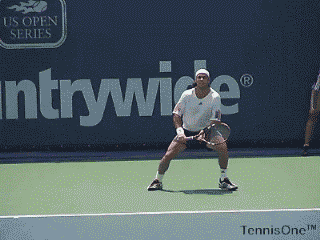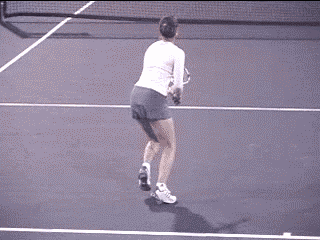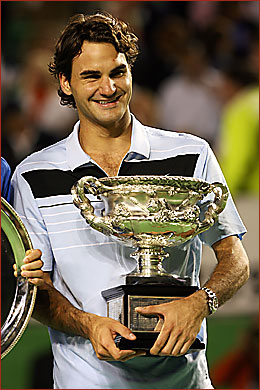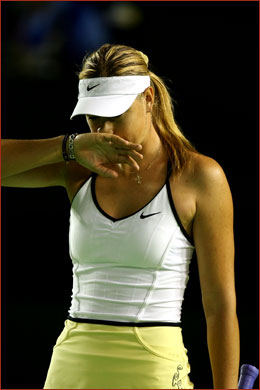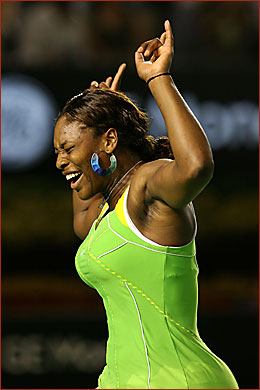|
TennisOne Lessons Tokyo Australian Open Musings Philippe Azar
There are eight weeks in the year where I do a rain-dance in the hope that it will submerge the Tokyo Lawn Tennis Club courts. Four Slams, each one lasting two weeks makes eight weeks.
The last two weeks, my rain-boogie worked and I got to watch quite a bit of the Australian Open.
For those of you who missed most of the action Down-Under, the following is a fruit salad of tactical and technical observations and general musings of the tournament. It’s official, the backspin backhand is back in a big way - amongst the men anyway. Time and again, and more so than I have seen in the last decade, the men are using backspin not just as a defensive/retrieval shot but also as a rallying shot. Gonzalez and Federer (who – it just so happens – were the two finalists) used it to best effect. In fact, Gonzalez attributes his recent success on his coach’s insistence that he replace his ripper topspin inconsistent backhand with a steady backspin. Tactically, the shot is used one-dimensionally: cross-court to the opponent’s backhand. Players have realized that a good backspin that stays low does not have to be hit deep. Even a short backspin is a tough prospect for the opponent as long as it stays low as they will be forced the hit up and put arc on the ball which very often gives time to the other player to set up for a forehand.
So the future looks bright right now and I suspect we can expect a generation of players to come through in the next 10 of 15 years with one-handers. The advantages and disadvantages of both have been much debated and essentially, it’s a draw. So there is no rational on that basis for a youngster to choose one over the other. However, what does make a difference to an aspiring tennis-kid is what kind of backhand his hero uses. If he idolizes Federer, he will most likely strive to develop a one-handed whilst the opposite would be the case if he idolized Roddick. It follows that if the next five or ten years are to be dominated by top players with one-handers, the likeliness of a generation of youngsters having a one-handed backhand will increase exponentially. A New Shot A new kind of shot, previously categorized as “trick shot,” is emerging as an essential and standard component in the arsenal of professionals, especially amongst the women: the swinging topspin volley. Even recently, it would have been blasphemous for anyone to put the words “swing” and “topspin” in the same sentence as “volley.” But, hey, we have to move with the times and this shot certainly works. And if it means that women will make a more regular – albeit rare - foray to the net, I’m all for it. Again and again, players like Sharapova, Williams, and Hingis were witnessed using it very effectively.
It requires the player to stand a little further back from the Ideal Volley Position and to make contact above the net. The reasons why women like this shot are obvious and multiple: for one, it is more powerful and offensive than a backspin volley and is therefore more likely to be put away instantly without the danger of (heaven-forbid!) having to play another volley. The second advantage is that, if the ball should come back as a lob (heaven-forbid), the fact that they are standing around the service line will help prevent them from having to run too far backwards and play a smash (heaven-forbid!). The third is that, because they don’t have to go all the way to the net (heaven-forbid!) and leave the comfort of the baseline behind, they won’t feel like a duck out of water. The fourth is that they won't have to learn how to volley (heaven-forbid!). Why-Oh-Why! Why-oh-why do they insist on approaching cross-court? Time and again, I witnessed some of the top guys approaching the net cross-court only to get passed down-the-line. The main protagonist of this was Roddick, with Blake, Murray, and a couple of others also guilty. Under normal circumstances, we all know approaching down-the-line is preferable. Occasionally, approaching cross-court might be justified if there is a clear opening or if an opponent has a flagrant weakness on that side. However, none of the current crop of top players got to the top with a “flagrant weakness,” and all have the ability to hit effectively down-the-line. What I just don’t get is why Roddick and Company insist on doing it again and again only to get passed again and again. Doesn’t a little light go on in their craniums after the up-teenth time, saying “Hmmm, this obviously ain’t workin'. Let’s hit it down-the-line next time”?! Are the top players really that oblivious to trends during a match? And even if that were the case, don’t they hire super-expensive tennis coaches to tell them right from wrong? Andy, hire me, I only charge US$70 an hour but you can pay me in Center Court tickets. If you’ve never spoken to an Australian, than you’ve never heard “Blimmey” which is a commonly used Aussie expression of positive surprise, a little bit like WOW! There were two memorable “Blimmey” moments at this year’s tournament. 1. As the old saying goes: “there are three kinds of people in the world: those who make things happen, those who watch things happen, and those who wonder what just happened.” The most outstanding Blimmey moment (because it did seem like no more than a moment) was surely Federer’s demolition of Roddick in the semis. Federer made things happen, Roddick watched as it happened and when it was all over, they both wondered what just happened. Federer brought “I was in the Zone” to new levels. I cannot say enough about that match. The general consensus amongst sporting commentators who have watched the greats over the past decades is that Federer’s performance on that night was quite possibly the all-time greatest demonstration of tennis. When I had spoken to Federer in summer 2005, shortly after he had absolutely embarrassed Roddick in the finals of Wimbledon in an astonishing performance, I had asked him if he thought he could ever play better than in that match. He smiled and said “Probably not.” Well, sorry Rog, you were wrong because you did. The scoreline of 6-4, 6-0, 6-2 does not do justice of the masterclass that Federer delivered. It was over before it started. If you get a chance to see a tape of it, do! It goes without saying that Federer and Gonzalez were the most deserving and consistently good players through the length of the tournament and earned their way to the final. Federer ended up winning the Australian Open without dropping a set, the first time anyone has done that in any Grand Slam since Bjorn Borg in 1980. My biggest disappointment was the state of the women’s game. Things just don’t seem to be progressing in the right direction. There was not one individual match that was remotely exciting or memorable. It just seems like all the ladies are happy to be clones of one another with a uniform style of banging ball after ball from the baseline with the winner being the one who can hit it the hardest or who can keep the ball in court. No imagination, no touch, no angles, no variations.
It was nice to see a couple of new faces creep their way into the quarters (in the form of Shahaar Peer and Lucie Safarova), but they both turned out to be more clones. Even Hingis, who had based her former successes on outwitting opponents with spins, angles and the such, seems to have degraded her game to trying to out-power her opponents. I guess they all know what they need to do to win matches and feel that power is the way to do it but it does not make for a great spectacle and I’m afraid that women’s tennis will be the looser. To top it off, the final between Serena and Sharapova was probably one of the most one-sided finals I can remember since Steffi Graf’s trouncing of Aranxta back in 1994. Not a good year for the ladies unfortunately. Furthermore, it doesn’t bode well for the women’s game that so many of them can take a number of years off and make a successful comeback a-la-Seles, Hingis, and Capriati. As exciting as it is for the fans to see former champions attempt comebacks, it shows that the women’s game just isn’t progressing if a former star can veg out for three years and then pick up a racquet again as if no time had passed. The ultimate insult for the women happened a couple of years ago when the half-a-century old Navratilova came back and beat a few of her daughter-old colleagues. This year wont go down as a vintage year because there were too may lop-sided matches and the women did not provide a great show. But the Australian Open has become an essential part of the tour now and the players and fans will be back for more next year. Your comments are welcome. Let us know what you think about Philippe Azar's article by emailing us here at TennisOne.
Philippe Azar is a professional with Peter Burwash International (PBI) and has been teaching tennis internationally for more than 15 years. He is presently based at Tokyo Lawn Tennis Club in Japan. PBI contracts with resorts, hotels and clubs all over the world to direct tennis programs.The company presently has professionals working at 62 facilities in North America, Europe, Asia, Middle East, Caribbean, Pacific and Indian Ocean. During its 30 years in business, PBI tennis professionals have taught tennis to over three million students in more than 135 countries. For more information visit: pbitennis.com |
